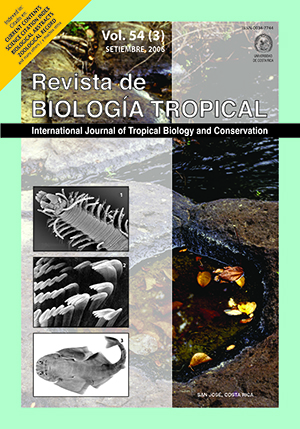Resumen
Diadema antillarum es un erizo de aguas someras del Atlántico tropical cuyas poblaciones fueron diezmadas entre los años 1983-1984 con mortandades de hasta 87- 100 %. En Venezuela, las densidades registradas antes de la mortalidad presentaban valores similares a los de otras regiones del Caribe, sin embargo se desconoce las abundancias posteriores al evento. Los objetivos del presente estudio fueron evaluar las densidades recientes de algunas poblaciones de D. antillarum a lo largo de las costas de Venezuela y comparar las densidades de la Bahía de Mochima antes y después de la mortandad. Se utilizaron transectos, y cuadrantes de 1m2 como unidad muestreal. Se registraron las mayores densidades promedio en las localidades del litoral central: Ensenada de Oricao con 0.28 ind/m2 (2002) y 1.05 ind/m2 (2003), y Chichiriviche de la Costa con 0.84 ind/m2 (2002) y 0.74 ind/m2 (2003). En la Bahía de Mochima, la densidad promedio antes de la mortandad de D. antillarum osciló entre 0.28 y 4 ind/m2, luego del evento de mortandad la densidad promedio varió entre 0.15 ind/m2 (2000) y 0.47 ind/m2 (2002). Las poblaciones de D. antillarum estudiadas en el Parque Nacional Morrocoy y Refugio de Fauna Silvestre Cuare presentaron las densidades promedio más altas en Playuela (0.43 ind/ m2) y Cayo Sur (0.95 ind/m2), mientras que las demás áreas presentaron densidades inferiores a 0.1 ind/m2. La densidad registrada en Playuela en el 2003 es menor a la informada antes del evento de mortandad (0.58-3.64 ind/m2). La densidad del Parque Nacional Archipiélago Los Roques, específicamente en el Arrecife de Herradura, se mantuvo constante durante 2002-2003, con valores entre 0.22 y 0.23 ind/m2 respectivamente. En conclusión, las abundancias registradas en la mayoría de las localidades evaluadas en Venezuela son superiores a las informadas para áreas al norte del Caribe, aunque todavía no se ha alcanzado los niveles anteriores a la mortalidad de 1984 por el lento incremento de las poblaciones.
##plugins.facebook.comentarios##

Esta obra está bajo una licencia internacional Creative Commons Atribución 4.0.
Derechos de autor 2006 Revista de Biología Tropical


